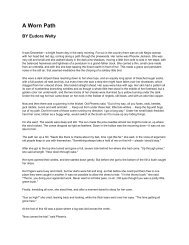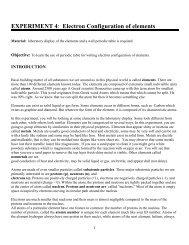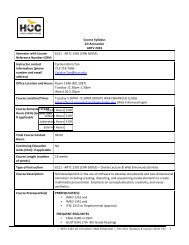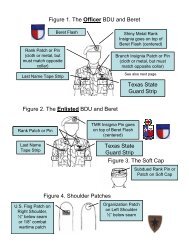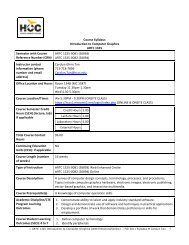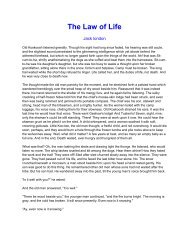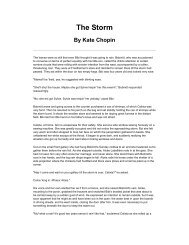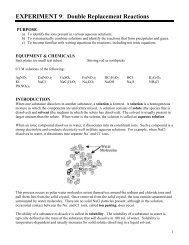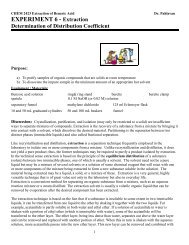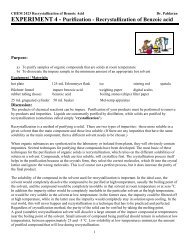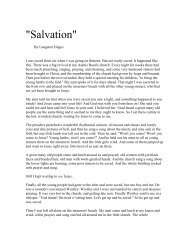EXPERIMENT 1 (Organic Chemistry II)
EXPERIMENT 1 (Organic Chemistry II)
EXPERIMENT 1 (Organic Chemistry II)
You also want an ePaper? Increase the reach of your titles
YUMPU automatically turns print PDFs into web optimized ePapers that Google loves.
<strong>EXPERIMENT</strong> 1 (<strong>Organic</strong> <strong>Chemistry</strong> <strong>II</strong>)Infra-Red (IR)- Nuclear Magnetic Resonance (NMR)Exercises In Molecular Spectroscopy- Structural DeterminationDr. PahlavanPurpose : to determine the structure of organic compoundsDiscussion :Unknown compounds may be isolated from natural sources or may be the result of laboratory synthesis. Indetermining their structure, physical properties such as boiling point and density are collected. Such data areuseful for comparing the unknown to known compound but contain little definitive structural information.Qualitative chemical tests may be carried out to obtain structural information. For example, you carried out thebromine and Baeyer tests to characterize the double bond of cyclohexene. Qualitative chemical tests are notunambiguous. More than one functional group may give the same positive test. Bromine and potassiumpermanganate react with other functional groups in addition to reacting with the double bond. An addition,qualitative chemical tests are destructive. The unknown cannot be recovered after the test. This is a greatdisadvantage if only a limited amount of the unknown is available.Spectroscopy – Spectroscopic methods provide useful information about the structure of organic compound. Inabsorption spectroscopy, we study the interaction of molecules with electromagnetic radiation. Frequently,absorption at a particular frequency indicates the presence of a specific structural unit within the molecule.Spectroscopy is advantageous because it is rapid and non-destructive. The sample may be recovered after study.Usually only a small quantity is required and much structural information is present in each spectrum. Spectra thatare routinely used to obtain structural information by organic chemists are ultraviolet, UV; infrared, IR; andnuclear magnetic resonance, NMR. In this experiment you become familiar with the characteristic absorptionbands of several common functional groups.Directions:Study text or any other organic text to identify the structure of each compound using the following spectrums.Please write your answers clearly in space provided.IR Spectrum:I. Learn and locate the wavelength of maximum of each IR band<strong>II</strong>.Learn to study each IR spectrum and identify functional group present such as hydroxyl group,carbonyl group, carboxylic group, ………….NMR Spectrum:I. Learn to locate the 1 H NMR chemical shift of each type in the spectrum.<strong>II</strong>.<strong>II</strong>I.Learn to interpret the integration signals and how to interpret the splitting of coupled protons.Study each spectrum and deduce the molecular structure by proton NMR (PMR) spectra.1
Helpful informationProton NMR Chemical Shifts• Electronegative groups are "deshielding" and tend to move NMR signals from neighboring protons further"downfield" (to higher ppm values).• Protons on oxygen or nitrogen have highly variable chemical shifts which are sensitive to concentration,solvent, temperature, etc.• The -system of alkenes, aromatic compounds and carbonyls strongly deshield attached protons and movethem "downfield" to higher ppm values.Common H NMR Splitting PatternsThe examples given above represent only the simplest and most common coupling patterns seen in the H NMR.I. A simple ethyl group displays a quartet and a triplet in the ratio 2:3; the chemical shift of the CH group issensitive to the attached substituent and typically varies between 4 (for oxygen) to 2 (for a carbonyl).<strong>II</strong>. An isopropyl group displays a septet (7 peaks) and a doublet in the ratio 1:6; again, the chemical shift of theCH group is sensitive to the attached substituent and typically varies between 4 (for oxygen) to 2 (for acarbonyl).<strong>II</strong>I. A 1,4-disubstituted aromatic compound displays two doublets in the ratio of 1:1, typically in the region around7.IV. In spite of the fact that there are three different types of hydrogens in a monosubstituted aromatic compound,the H NMR typically displays a single peak in the region around 7. This is because the differences inchemical shift are typically small, as are the coupling constants.2
<strong>EXPERIMENT</strong> 1 (<strong>Organic</strong> <strong>Chemistry</strong> <strong>II</strong>) Dr. PahlavanREPORT FORMName _______________________________Instructor ___________________________Date ________________________________Questions1. How could you tell if an unknown is an alcohol by examining its IR spectrum?2. How could you distinguish between cyclohexane and cyclohexene using IR?3. In general how could you identify a compound as an alkane, alkene, alkyne, or arene using IR?4. An unknown has the following physical data:Molecular formula of C 3 H 8 OIR: 3400, 2950, 1460, 1385, 1365, 1100 cm -1Draw the structures consistent with the analysis. Which one is consistent with the IR data? Assign absorptionto support your answer.5. Give absorption frequency range ( in cm -1 ) for each of the following.-O-H stretch __________ -CO- stretch ______________ -C-H stretch ________________≡ C –H stretch __________ = C-H ___________3
Problem 1 – C 5 H 10 O4
Problem 2 - C 5 H 10 O 25
Problem 3 – C 6 H 14 O6
Problem 4 – C 8 H 8 OProblem 5 – C 9 H 10 O 27
Problem 6 – C 3 H 6 O 2Problem 7 – C 7 H 9 N9
Problem 8 – C 8 H 14 O11
Problem 9 – C 4 H 9 Br12




